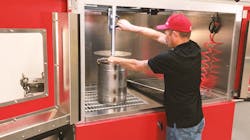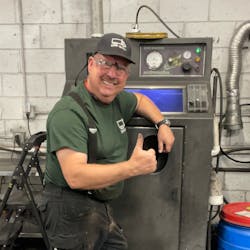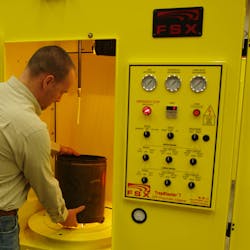In many instances, a diesel particulate filter failure is the result of an upstream failure. In some cases, however, the blame rests squarely on the DPF—or perhaps those who failed to properly maintain it.
What’s a good maintenance schedule?
“It really has a lot to do with duty cycle,” said Jim Sutherland, director of equipment sales at Enviromotive, manufacturer of EvacuBlast DPF cleaning and testing equipment.
“We like to throw out 100,000 miles as a starting point,” added Jake Litell, an Enviromotive sales representative. “If you’re idling a lot, it could be sooner. If you’re always on the highway, it could be longer.”
The point is that you want to stay ahead of any issues. You also want to make sure the DPF is cleaned really well.
James Wendt, managing partner at DPF Guys in Atlanta, uses EvacuBlast DPF cleaning equipment. He has a compressed air/vacuum machine and an aqueous flush system. Wendt often uses both methods to ensure a cleaner DPF that’s ready to resume service.
“Of the 300 or so DPFs we clean a month, maybe two or three actually have to be condemned,” Wendt said. “But 99% can be cleaned. You just need to have the right cleaning equipment and cleaning process. The goal is to get that DPF as close to new as possible before it goes back on the truck.”
Another goal is to keep downtime to a minimum while still ensuring that your DPFs are properly maintained.See also: Aftertreatment exorcisms made easy
Bringing cleaning in-house
When fleets begin moving toward a more frequent DPF cleaning interval, the idea of bringing cleaning in-house becomes more intriguing. This is especially true if the fleet is also looking to get more proactive with cleaning the DOC and SCR.
Steve Hoke, president of Diesel Emissions Service, said their most successful fleet customers adhere to a regular maintenance regimen on all stages of the aftertreatment system. “These fleets start crunching the numbers on what it would cost and how much downtime they could save,” Hoke said. “When cleaning in-house, it’s possible to pull, wash, dry, and reinstall a DPF in a couple of hours. That’s a same-day procedure, and the vehicle is back on the road.”
According to Jeremy Anderson, VP of sales at FSX Equipment, if a fleet wants to see a positive ROI on its aftertreatment cleaning equipment within a year or so, it’s going to need around 100 vehicles. That said, a smaller fleet of even 10 to 15 trucks could still see a quick ROI. The trick is creating additional income by offering cleaning services to other truck owners.
Daniel Barandalla, owner of D&I Farms in Fresno, California, is one such fleet owner. He purchased Filtertherm cleaning equipment to take care of his own 35-truck fleet after becoming frustrated with long wait times during COVID. He has since developed a standard practice of cleaning a truck’s DPF once a year during its annual inspection. A truck has generally accumulated 120,000 miles at that time.
Now Barandalla has a second company, D&I DPF Cleaning, that services other fleets. “I started out cleaning for my inner circle of truck owner friends,” Barandalla said. “Word got out pretty quickly and the business has grown. I have my own team of technicians who also handle the DPF cleaning for our customers. It has worked out very well.”
About the Author

Gregg Wartgow
Gregg Wartgow is a freelancer who Fleet Maintenance has relied upon for many years, writing about virtually any trucking topic. He lives in Brodhead, Wisconsin.


